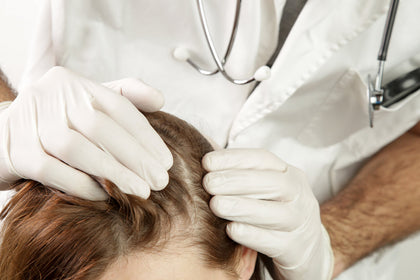If you or someone you know struggles with male pattern baldness or female pattern hair loss, then you might have heard about hair transplant surgery. Once known colloquially as "getting plugs," hair restoration surgery can help someone who is dealing with severe hair loss. Read on to find out more about what a hair transplant is, how much it costs and what products you can use to combat hair loss naturally.
What Does a Hair Transplant Cost?
Hair transplants are not cheap, ranging between $4,000 and $15,000, with the actual cost depending on various factors, including the number of grafts you receive to restore your hair loss. Doctors will often charge a price per graft, such as $4 to $10, and the more grafts you get, the less expensive the per-graft price may be.
"The cost of a hair transplant will also depend on the geographic location where you are receiving treatment," said Dr. Daniel Boyer an M.D. focusing on medical research. "Hair transplant clinics in major cities tend to charge higher rates than clinics in rural areas. Additionally, clinics that offer high-end amenities, such as private rooms and luxury
amenities, tend to charge higher rates than those with essential treatment with little to no frills."
Unfortunately, most of the time, hair transplant procedures are not covered by health insurance plans because they are considered cosmetic procedures. However, some hair clinics do offer specials and payment plans to help clients cover the cost of hair transplants.
Shop: Best-Selling GRO More Kit for Thinning Hair
How Does a Hair Transplant Work?
Dealing with hair thinning or hair loss can be a huge blow to one's self-esteem. According to one study, 70% of men reported feelings of lower self-esteem when dealing with balding and hair loss. When someone struggling with hair loss has exhausted all of their options, and a medical professional has determined that nothing else is working, patients will often look to hair restoration to cope with their hair thinning or hair loss.
"With a hair transplant, a huge patch of lost hair can be replaced permanently, said dermatologist, Dr. Cory Gaskins. "The success rate for graft survival is more than 90%.”
There are two kinds of hair restoration procedures: FUT (follicular unit transplantation) and FUE (follicular unit extraction).
With FUT — also known as the strip method — a strip of scalp is cut from an area that is growing hair. Next, that strip is cut up into grafts that are transplanted into the area on the head that is not growing hair. This method isn't often preferred as it can leave a long scar on the back of the patient's head from the strip that is removed. The upside to FUT is that the harvesting time is much quicker for patients. The strip of scalp is cut, and the area is then sutured.
With FUE, individual hair follicles are harvested from the back of the scalp, or other places on the body designated as appropriate by a surgeon. They are then implanted into the scalp where hair loss has occurred. This method leaves smaller scars on the patient's head, but it does take a long time to extract the grafts. In some cases, FUE can cost more than FUE because it is a more time-intensive procedure.
“During the [FUE] procedure, a surgeon will harvest individual hair follicular units from the donor area," said Dr. Gaskins. "Each follicular unit consists of one to three hairs. The surgeon will then create small incisions in the recipient area and insert the follicular units into these incisions.”
Shop: Fatima Dedrickson's Vegamour Picks
Hair Transplant Surgery Aftercare
About two days after hair transplant surgery, some patients might experience mild facial swelling around the forehead area that will last a few days. Additionally, patients will likely have to apply a prescribed ointment at both the donor and recipient graft sites to help with the healing process.
Patients will be given detailed aftercare instructions from their doctor, which might include having to sleep in a more upright position for a few days after surgery if their doctor recommends it.
Downsides of Hair Transplantation
Having a brand-new head of hair might sound like a fantastic plan for anyone who has been struggling with hair thinning, hair loss or hair fall. However, hair restoration is not without its risks and downsides. For example, according to this study, there is a possibility of experiencing TE (telogen effluvium) at the donor or recipient site. This is likely due to microtrauma experienced during the procedure. This hair loss is temporary, however, and hair follicles should produce new hairs once the system settles down.
Related: What Is Telogen Effluvium? One Type of Hair Loss Explained
Alternative Options
#include-related-slider#
If hair restoration isn't for you or someone you know who may be struggling with hair loss, there are alternative options. Many patients who are struggling with hair loss will rely on some sort of medical intervention, such as the following:
Prescription Drugs
“Topical minoxidil is one popular alternative treatment for hair loss," said Dr. Gaskins. "This medication is applied directly to the scalp and is thought to stimulate hair growth. Oral finasteride is another popular alternative treatment option. This medication works by reducing the amount of DHT in the body, which can help to prevent further hair loss."
Hair loss drugs do have side effects. Do your research so you fully understand minoxidil side effects, as well as the side effects of finasteride.
See: The Major Difference Between VEGAMOUR and Minoxidil
Low-Level Light Therapy
Low-level light therapy is another potential treatment option for hair loss that many patients will try. "This therapy involves using low-level lasers or LEDs to stimulate blood flow to the scalp. This increased blood flow and cell metabolism can help to promote hair growth," Dr Gaskins explained.
Platlet-Rich Plasma Therapy
PRP (platelet-rich plasma therapy) is another option where plasma is inserted directly into the scalp where hair thinning is occurring to try to revive the hair follicles. One study showed significant reduction in hair loss and an increase in hair volume for men who opted for PRP after failing to get results from other hair loss medications.
Also: What You Should Know About PRP for Hair Loss
A More Affordable Natural Approach to Thinning Hair
While hair restoration is effective for many patients, it can be expensive and time-consuming. If you can find a better balance by adjusting your lifestyle or using natural products, why not give them a try first?
VEGAMOUR GRO Hair Serum is free of toxic chemicals, carcinogens and harmful side effects. It's also cruelty-free and 100% vegan. Additionally, the serum is lightweight, non-greasy and packed with powerful phyto-actives, including mung bean, curcumin and red clover, which have been shown in multiple clinical studies to increase the appearance of hair density while reducing signs of shedding to encourage thicker, fuller-looking hair in as soon as 90 days.
Read Rheonna's Story: Minoxidil Didn't Work for Me But VEGAMOUR Did
The Takeaway
For some people, hair transplant surgery might be the only option if their hair loss has progressed to the point that other restoration methods will not revive it. However, opting for a hair transplant is not a decision to make lightly. If you are experiencing hair loss that is in the earlier stages, the first step is to chat with your healthcare provider to ensure that your hair loss is not related to an underlying health condition.
If your health is good and you are experiencing hair fall or thinning hair, there are other approaches that can be utilized, including VEGAMOUR's natural alternatives that are clinically tested and offer proven results to help you combat your thinning hair.
#include-related-slider#
More From VEGAMOUR
- Shop: The Best Products for Thinning Hair
- Look Out for These 7 Signs of Balding
- How to Handle a Mature Hairline
- What Causes Female Hair Loss at the Temples
Photo credit: triocean/iStock




















